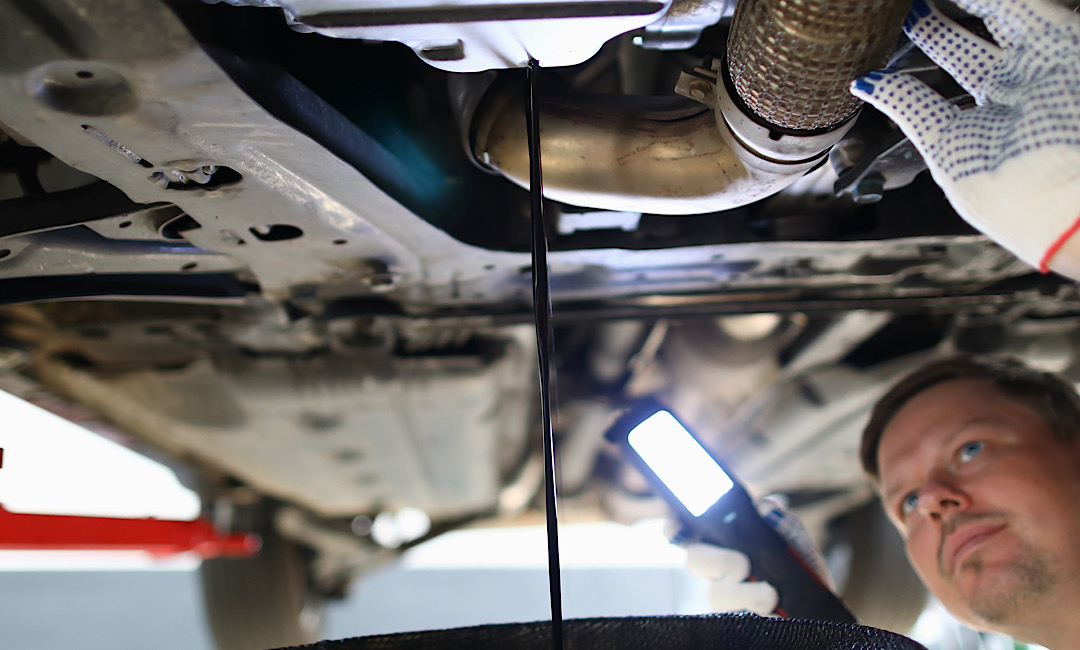Your vehicle’s braking system is one of the most important safety features on the road. Yet, many drivers in Boise overlook a critical component that keeps those brakes functioning properly—brake fluid. As vehicles have become more advanced, especially with the integration of Anti-lock Braking Systems (ABS) and electronic stability controls, proper brake fluid maintenance has never been more vital.
At Naylor’s Auto Repair, we routinely educate drivers about the importance of maintaining clean, properly rated brake fluid to ensure reliable stopping power, especially on Idaho’s steep grades and icy winter roads. Understanding when to flush brake fluid, the differences between DOT 3 and DOT 4 fluids, and how the ABS system interacts with your brakes can make a major difference in both safety and performance.
What Brake Fluid Does and Why It’s So Important
Brake fluid is a hydraulic fluid that transfers the pressure from your brake pedal to the brake pads or shoes, enabling your vehicle to stop. When you press the pedal, the master cylinder compresses the brake fluid, sending force through the lines to each wheel. The fluid must remain clean, non-compressible, and resistant to high heat to ensure consistent braking.
Over time, brake fluid becomes contaminated with moisture, debris, and metal particles from normal wear inside the braking system. Moisture is the most damaging contaminant—it lowers the fluid’s boiling point, which can cause brake fade or total loss of braking performance under heavy use.
In Idaho, where Boise drivers frequently transition between dry summers and cold, humid winters, brake fluid is especially prone to absorbing water. This makes regular flushing and fluid replacement essential to prevent corrosion, internal damage, and dangerous brake failure.
Understanding DOT 3 vs. DOT 4 Brake Fluid
Brake fluid is categorized by its DOT (Department of Transportation) rating, which specifies its boiling point and chemical composition. Most vehicles today use either DOT 3 or DOT 4 fluid. Knowing the difference helps ensure you choose the right product for your car and driving conditions.
DOT 3 Brake Fluid
- Base: Glycol-ether
- Boiling Point (Dry): Around 401°F (205°C)
- Boiling Point (Wet): Around 284°F (140°C)
- Absorption Rate: Absorbs moisture relatively quickly
- Applications: Common in older vehicles and standard passenger cars
DOT 3 is widely used and cost-effective, but absorbs water faster than DOT 4. This means it generally requires more frequent replacement, especially in regions with temperature fluctuations like Boise.
DOT 4 Brake Fluid
- Base: Glycol-ether with borate esters
- Boiling Point (Dry): Around 446°F (230°C)
- Boiling Point (Wet): Around 311°F (155°C)
- Absorption Rate: Slower moisture absorption than DOT 3
- Applications: Recommended for vehicles with ABS, traction control, or performance braking systems
DOT 4 brake fluid offers higher heat resistance and is better suited for modern vehicles equipped with ABS. Since the ABS pump can generate more heat during operation, DOT 4’s higher boiling point helps prevent vapor lock—a condition where air bubbles form in the brake lines, compromising braking pressure.
At Naylor’s Auto Repair, we recommend checking your owner’s manual before switching fluid types. Mixing DOT 3 and DOT 4 is not ideal, as it dilutes the performance of the higher-grade fluid.
When to Flush Your Brake Fluid
Unlike engine oil, brake fluid doesn’t get used up—but it does degrade over time. The recommended flush interval varies by manufacturer, but most modern vehicles should have their brake fluid replaced every 2 to 3 years or every 30,000 miles, whichever comes first.
For Boise drivers, we suggest testing brake fluid annually due to Idaho’s variable climate. Vehicles exposed to frequent elevation changes, humidity, or road salt should be serviced even more regularly to avoid corrosion in the brake lines and ABS components.
Signs You May Need a Brake Fluid Flush
- The brake warning light or ABS light is illuminated.
- The brake pedal feels spongy, soft, or sinks slowly when pressed.
- You hear grinding or squealing noises during braking.
- Your stopping distance has increased, or braking feels inconsistent.
- The fluid in the reservoir looks dark or dirty instead of light amber.
If any of these signs appear, it’s time to schedule a professional inspection. At Naylor’s Auto Repair, we use advanced brake fluid testers to measure moisture content and determine exactly when a flush is needed—never sooner, never later.
How ABS Affects Brake Fluid and Maintenance
Modern braking systems rely heavily on ABS, which prevents wheel lock-up during emergency stops by rapidly pulsing brake pressure to each wheel. While this technology dramatically improves safety, it also places greater stress on brake fluid and hydraulic components.
When ABS engages, it activates a high-pressure pump that circulates fluid rapidly. This can generate intense heat and turbulence within the system. If the fluid is old or contaminated with moisture, the increased temperature may cause vapor formation or corrosion inside the ABS module—an expensive part to replace.
Best ABS Maintenance Practices
- Flush brake fluid at regular intervals. Fresh fluid reduces corrosion risk and keeps the ABS solenoids responsive.
- Inspect ABS sensors and wiring annually. These sensors ensure each wheel receives proper braking pressure.
- Use the correct fluid type. DOT 4 is typically better suited for vehicles equipped with advanced braking systems.
- Avoid running the brake fluid reservoir too low. Air entering the system can trigger ABS warning lights and reduce braking efficiency.
- Test drive after service. At Naylor’s Auto Repair, we verify proper ABS operation after each brake fluid flush to ensure system integrity.
The Consequences of Neglecting Brake Fluid
Neglecting brake fluid replacement is a leading cause of premature brake and ABS failure. When moisture accumulates in the system, it corrodes metal components like the master cylinder, brake calipers, and ABS pump. Over time, this can lead to:
- Reduced braking power due to fluid compression
- Increased stopping distance, especially in emergencies
- Expensive ABS repairs, often exceeding $1,000
- Total brake failure in extreme cases
According to the National Highway Traffic Safety Administration (NHTSA), poor brake maintenance is a contributing factor in nearly 22% of preventable vehicle accidents each year. Regular fluid service is an affordable and simple way to prevent those risks.
Boise Climate & Its Impact on Brake Systems
Boise’s weather can shift from 100°F summers to freezing winter mornings within a few months. These drastic temperature swings cause brake fluid to expand and contract, increasing the rate of moisture absorption. Combined with Idaho’s dry air and occasional road salt exposure, this creates the perfect environment for internal rust and seal degradation.
At Naylor’s Auto Repair, we often see Boise vehicles with dark, contaminated fluid after only two years of use—especially among commuters driving up Highway 55 or through Bogus Basin’s elevation changes. Keeping brake fluid fresh not only ensures stopping power but also protects the sensitive ABS components that Idaho drivers depend on during icy road conditions.
Expert Boise FAQs About Brake Fluid & ABS Maintenance
1. How often should brake fluid be changed in Boise’s climate?
Most manufacturers recommend every 2 to 3 years, but Boise drivers should have their brake fluid tested annually due to the area’s temperature fluctuations and moisture exposure.
2. Can I mix DOT 3 and DOT 4 brake fluid?
Technically, yes, but it’s not ideal. Mixing dilutes the higher heat resistance of DOT 4 fluid. Always use the type recommended in your vehicle’s manual.
3. Is a brake fluid flush the same as a brake bleed?
No. A brake bleed removes air pockets from the lines, while a flush replaces old fluid with new, removing moisture and contaminants throughout the entire system.
4. What happens if I never flush my brake fluid?
Over time, moisture buildup can corrode the ABS module and internal lines, leading to brake fade, warning lights, or complete failure of the hydraulic system.
5. How much does a brake fluid flush cost in Boise?
At Naylor’s Auto Repair, the average cost ranges between $100 and $150, depending on vehicle type. It’s a small investment compared to replacing major components later.
Why Boise Drivers Trust Naylor’s Auto Repair
When it comes to brake maintenance and ABS service, Boise drivers trust Naylor’s Auto Repair for honest advice, expert service, and safety-focused care. Our ASE-certified technicians use manufacturer-approved brake fluids, precision bleeding equipment, and electronic ABS diagnostics to ensure every vehicle stops reliably—whether it’s navigating downtown traffic or icy morning commutes.
We take pride in helping our community drive more safely by preventing small maintenance issues from turning into major repairs.
Don’t wait for your brake light to come on. Schedule a brake inspection and fluid flush at Naylor’s Auto Repair today to keep your stopping power strong through Boise’s changing seasons.



.jpeg)